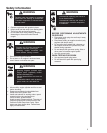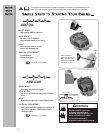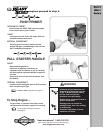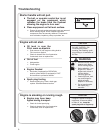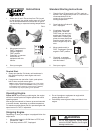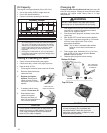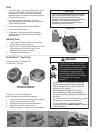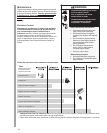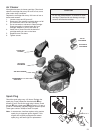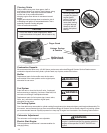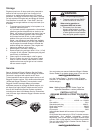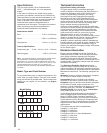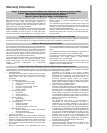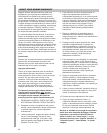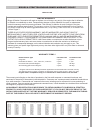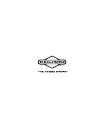
16
Specifications
This is a single cylinder, Direct Overhead Valve
(DOVt), air-cooled engine. It is a low emissions
engine.
In the state of California, the 100000 series engine
covered in this manual is certified by the California Air
Resources Board to meet emissions standards for 125
hours. Such certification does not grant the purchaser,
owner or operator of this engine any additional
warranties with respect to the performance or
operational life of this engine. This engine is warranted
solely according to the product and emissions
warranties stated elsewhere in this manual.
Model Series 100000
Bore 2.52 in. (64.00 mm). . . . . . . . . . . . . . . . . . . . . . . . . .
Stroke 1.968 in. (49.99 mm). . . . . . . . . . . . . . . . . . . . . . .
Displacement 9.82 cu. in. (161 cc). . . . . . . . . . . . . . . . . .
Tune-up Specifications
Armature air gap 0.006 − 0.014 in. (0.15 − 0.35 mm). .
Spark plug gap 0.020 in. (0.51 mm). . . . . . . . . . . . . . . . .
Note: For practical operation, the horsepower loading should
not exceed 85% of rated horsepower. Engine power will
decrease 3-1/2% for each 1,000 feet (300 meters) above sea
level and 1% for each 10° F (5.6° C) above 77° F (25° C). It will
operate satisfactorily at an angle up to 15°. Refer to the
equipment operator manual for safe allowable operating limits
on slopes.
Model, Type and Code Number
To get replacement parts or technical assistance in the
future write you engine Model, Type and Code number
along with the date of purchase here. These numbers are
located on your engine. For the location, see Engine
Features.
Model Series
Type
Code
Month/Day/Year
Technical Information
Engine Power Rating Information
The gross power rating for individual gas engine
models is labeled in accordance with SAE (Society of
Automotive Engineers) code J1940 (Small Engine
Power & Torque Rating Procedure), and rating
performance has been obtained and corrected in
accordance with SAE J1995 (Revision 2002-05).
Torque values are derived at 3060 RPM; horsepower
values are derived at 3600 RPM. Actual gross engine
power will be lower and is affected by, among other
things, ambient operating conditions and
engine-to-engine variability. Given both the wide array
of products on which engines are placed and the variety
of environmental issues applicable to operating the
equipment, the gas engine will not develop the rated
gross power when used in a given piece of power
equipment (actual “on-site” or net power). This
difference is due to a variety of factors including, but not
limited to, accessories (air cleaner, exhaust, charging,
cooling, carburetor, fuel pump, etc.), application
limitations, ambient operating conditions (temperature,
humidity, altitude), and engine-to-engine variability. Due
to manufacturing and capacity limitations, Briggs &
Stratton may substitute an engine of higher rated power
for this Series engine.
Emission Information
Engines that are certified to meet the California Air
Resources Board (CARB) Tier 2 Emission Standards
must display information regarding the Emissions
Durability Period and the Air Index. Briggs & Stratton
makes this information available to the consumer on our
emission labels. The engine emission label will indicate
certification information.
The Emissions Durability Period describes the
number of hours of actual running time for which the
engine is certified to be emissions compliant, assuming
proper maintenance in accordance with the Operating &
Maintenance Instructions. The following categories are
used:
Moderate: Engine is certified to be emission compliant
for 125 hours of actual engine running time.
Intermediate: Engine is certified to be emission
compliant for 250 hours of actual engine running time.
Extended: Engine is certified to be emission compliant
for 500 hours of actual engine running time. For
example, a typical walk-behind lawn mower is used 20
to 25 hours per year. Therefore, the Emissions
Durability Period of an engine with an intermediate
rating would equate to 10 to 12 years.
Certain Briggs & Stratton engines will be certified to
meet the United States Environmental Protection
Agency (USEPA) Phase 2 emission standards. For
Phase 2 certified engines, the Emissions Compliance
Period referred to on the Emissions Compliance label
indicates the number of operating hours for which the
engine has been shown to meet Federal emission
requirements.
For engines less than 225 cc displacement.
Category C = 125 hours
Category B = 250 hours
Category A = 500 hours
For engines of 225 cc or more displacement.
Category C = 250 hours
Category B = 500 hours
Category A = 1000 hours



